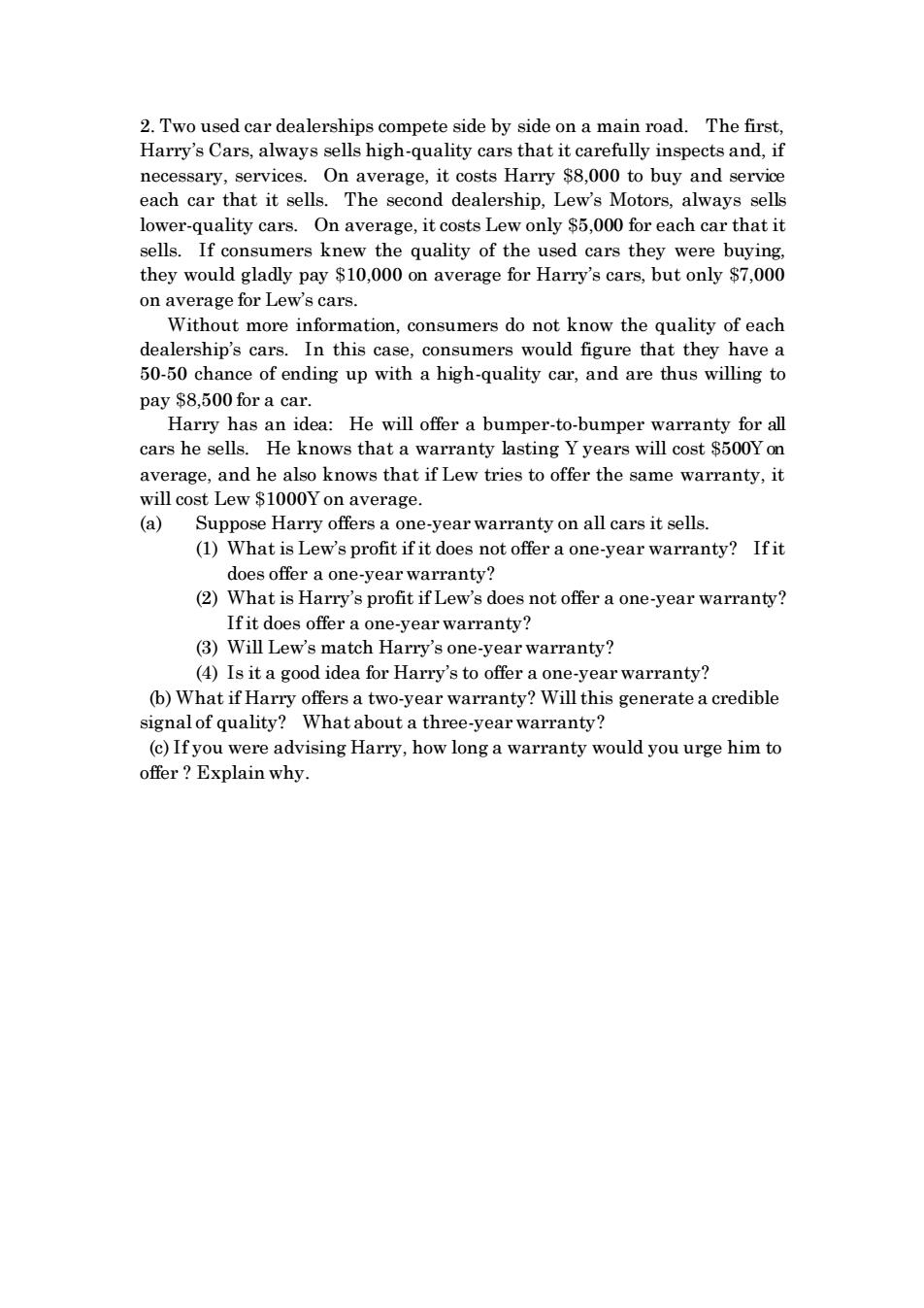正在加载图片...

2.Two used car dealerships compete side by side on a main road.The first, Harry's Cars,always sells high-quality cars that it carefully inspects and,if necessary,services.On average,it costs Harry S8,000 to buy and service each car that it sells.The second dealership,Lew's Motors,always sells lower-quality cars.On average,it costs Lew only $5,000 for each car that it sells.If co ners knew the e quality of the used cars they were buyin they would gladly pay1000naverage for Harry'cars but ony7000 on average for Lew's cars. Without more information,consumers do not know the quality of each dealership's ca rs In this c mer would figure that they have 50-50 chance of ending up with a high-quality car,and are thus willing to pay $8,500 for a car. Harry has an idea:He will offer a bumper-to-bumper warranty for all cars he sells.He knows that a warranty lasting Y years will cost $500Yon average,and he also knows that if Lew tries to offer the same warranty,it will cost Lew $1000Y on average. (a)Suppose Harry offers a one-year warranty on all cars it sells. (1)What is Lew's profit ifit does not offer a one-year warranty?Ifit does offer a one-year warranty? (2)What is Harry's profit if Lew's does not offer a one-year warranty? Ifit does offer a one-year warranty? (3)Will Lew's match Harry's one-year warranty? (4)Is it a good idea for Harry's to offer a one-year warranty? (b)What if Harry offers a two-year warranty?Will this generate a credible signal of quality?What about a three-year warranty? (c)If you were advising Harry,how long a warranty would you urge him to offer Explain why. 2. Two used car dealerships compete side by side on a main road. The first, Harry’s Cars, always sells high-quality cars that it carefully inspects and, if necessary, services. On average, it costs Harry $8,000 to buy and service each car that it sells. The second dealership, Lew’s Motors, always sells lower-quality cars. On average, it costs Lew only $5,000 for each car that it sells. If consumers knew the quality of the used cars they were buying, they would gladly pay $10,000 on average for Harry’s cars, but only $7,000 on average for Lew’s cars. Without more information, consumers do not know the quality of each dealership’s cars. In this case, consumers would figure that they have a 50-50 chance of ending up with a high-quality car, and are thus willing to pay $8,500 for a car. Harry has an idea: He will offer a bumper-to-bumper warranty for all cars he sells. He knows that a warranty lasting Y years will cost $500Y on average, and he also knows that if Lew tries to offer the same warranty, it will cost Lew $1000Y on average. (a) Suppose Harry offers a one-year warranty on all cars it sells. (1) What is Lew’s profit if it does not offer a one-year warranty? If it does offer a one-year warranty? (2) What is Harry’s profit if Lew’s does not offer a one-year warranty? If it does offer a one-year warranty? (3) Will Lew’s match Harry’s one-year warranty? (4) Is it a good idea for Harry’s to offer a one-year warranty? (b) What if Harry offers a two-year warranty? Will this generate a credible signal of quality? What about a three-year warranty? (c) If you were advising Harry, how long a warranty would you urge him to offer ? Explain why